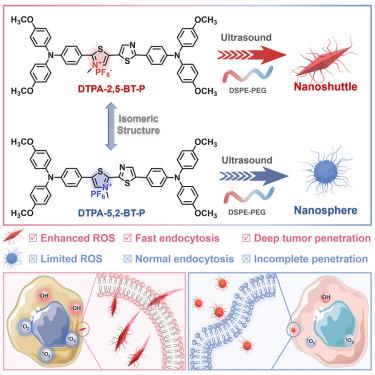异构光敏剂的穿梭式纳米组装可增强光动力疗法的 ROS 生成和肿瘤穿透力
IF 17.3
1区 材料科学
Q1 MATERIALS SCIENCE, MULTIDISCIPLINARY
引用次数: 0
摘要
光动力疗法(PDT)迫切需要能产生大量活性氧(ROS)并具有良好肿瘤靶向性和穿透性的光敏剂,但在制备有机聚集体时,同时实现所有这些目标仍具有挑战性。特别是由异构光敏剂组装成的不同形状的纳米聚集体尚未见报道。因此,我们开发了 DTPA-2,5-BT-P 和 DTPA-5,2-BT-P 的异构光敏剂,DTPA-2,5-BT-P 可以产生有效的分子间相互作用,而 DTPA-5,2-BT-P 则会产生分子内相互作用。这导致 DTPA-2,5-BT-P 形成晶体状纳米梭(NSs),而 DTPA-5,2-BT-P 则形成无定形纳米球(NPs)。值得注意的是,DTPA-2,5-BT-P NSs 产生的 ROS 比 DTPA-5,2-BT-P NPs 高。此外,DTPA-2,5-BT-P NSs 还能实现更快的细胞内化、更好的肿瘤靶向性和穿透性,从而在体内实现高效的光导疗法,抑制率高达 81%。这表明,紧密堆积的DTPA-2,5-BT-P NSs是一种很有前景的光敏剂,可用于癌症治疗中的高效PDT。本文章由计算机程序翻译,如有差异,请以英文原文为准。


Shuttle-like nanoassemblies by isomeric photosensitizers to enhance ROS generation and tumor penetration for photodynamic therapy
Photosensitizers with high reactive oxygen species (ROS) generation and good tumor targeting and penetration are urgently needed for photodynamic therapy (PDT), but it is still challenging when preparing organic aggregates to achieve all these goals simultaneously. In particular, nanoaggregates assembled by isomeric photosensitizers but in different shapes have not been reported yet. Therefore, isomeric photosensitizers of DTPA-2,5-BT-P and DTPA-5,2-BT-P are developed, where an efficient intermolecular interaction can be obtained in DTPA-2,5-BT-P but an intramolecular interaction occurs in DTPA-5,2-BT-P. This results in the formation of crystalline nanoshuttles (NSs) for DTPA-2,5-BT-P but amorphous nanospheres (NPs) for DTPA-5,2-BT-P. Notably, higher ROS generation occurs in DTPA-2,5-BT-P NSs than in DTPA-5,2-BT-P NPs. Moreover, faster cellular internalization and better tumor targeting and penetration can be achieved in DTPA-2,5-BT-P NSs, leading to efficient PDT in vivo with an inhibition rate of 81%. This demonstrates that closely packed DTPA-2,5-BT-P NSs can be promising photosensitizers for high-performance PDT in cancer therapy.
求助全文
通过发布文献求助,成功后即可免费获取论文全文。
去求助
来源期刊

Matter
MATERIALS SCIENCE, MULTIDISCIPLINARY-
CiteScore
26.30
自引率
2.60%
发文量
367
期刊介绍:
Matter, a monthly journal affiliated with Cell, spans the broad field of materials science from nano to macro levels,covering fundamentals to applications. Embracing groundbreaking technologies,it includes full-length research articles,reviews, perspectives,previews, opinions, personnel stories, and general editorial content.
Matter aims to be the primary resource for researchers in academia and industry, inspiring the next generation of materials scientists.
 求助内容:
求助内容: 应助结果提醒方式:
应助结果提醒方式:


